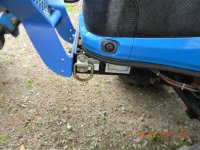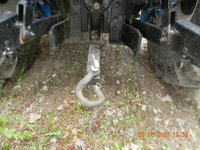As it was stated before, check your state laws. Many consider the FEL a separate implement and will require it be secured too. Usually, a chain or strap around the bucket will suffice. Here is how I load mine:
I always reverse onto the trailer. The tires are filled and I want more weight over the tongue than behind the axles of the trailer. More weight behind those axles will result in the "tail wagging the dog"
I prefer to use chains. I got mine from Home Depot
https://www.homedepot.com/p/Everbil...el-Tow-Chain-with-Grab-Hooks-803082/203958797 Good Price!
I bolt on D-rings to the front frame, just behind the brush guard and in front of the muffler on the left side.
Run the chain through the D-rings and use a chain binder to tighten. Anchor the chain to the trailer to make a 'V' pointed to the front of the trailer
Run a chain trough a clevis on the draw bar, hooking the chain to the trailer behind the draw bar to make a 'V' pointed to the rear of the trailer
This: >Tractor<
Not this: <Tractor<
Not This: >Tractor>
This is ok, but I dont like it: <Tractor>
Then, run a chain behind the support bar on the FEL or behind the bucket to secure it to the trailer. (Make sure the bucket is down flat on the trailer, not in float, but not pressing down hard on the deck)
Run a chain around any attached implements, this includes a backhoe. (Again, check your laws)
Make sure your trailer and truck can handle the weight. Its not about going, its about stopping. Using a 1/4 ton pickup to pull a tractor is not wise. It might be able to go down the road, but can it stop?
Always remember to set the parking brake in the tractor too.
Another thing to consider, no one has ever gotten a ticket for using too many tie downs. When it doubt, tie it down.
As far as being tractor specific, the laws dont use tractor specifics in their definitions. Just use common sense and dont bend anything. Hook to solid steel, not hydraulic cylinders. If it looks hokey, it is hokey and you need to make some adjustments.


